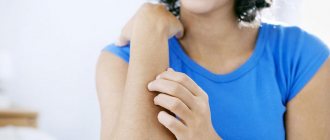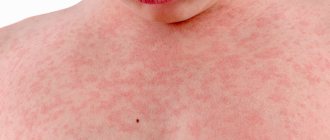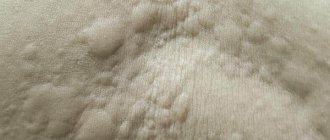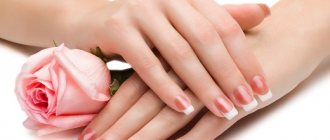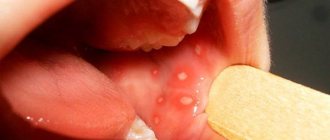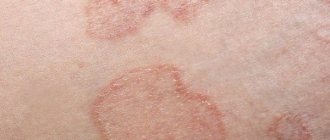Pityriasis (pityriasis alba) is a common, benign skin condition that usually affects children between the ages of six and twelve years. This condition is characterized by patches of lighter skin, mainly on the face, although the neck, upper chest and arms are sometimes involved.
The condition is named for its scaly appearance (from the Latin word "pityrus", meaning scales) and characteristic white patches ("alba" for white).
Clinic
Photo of white lichen in humans
The fungus does not harm the health of a child or an adult, does not irritate the skin and does not cause itching.
Sometimes pityriasis alba rises above the skin level and flakes off, as seen in the photo.
In this case, itching may appear, and in the cold season - an inflammatory process.
It changes the pigmentation of the skin because it prevents the penetration of sunlight and the appearance of melanin.
Therefore, on tanned human skin you can see these white spots on the face, shoulders, hips (see photo).
Pityriasis alba on the skin is an unpleasant cosmetic blemish, especially on visible parts of the body and face.
Symptoms and diagnosis of pathology
The symptoms of lichen simplex are very pronounced, which is impossible not to notice. But without examinations it is difficult to determine the presence of this particular disease, so it is important to consult a doctor at the first suspicion. Symptoms accompanying the disease:
- whitish patches that can spread throughout the body and sometimes peel off;
- a sharp difference in the color of the affected area from the color of healthy skin;
- if you press on the stain, it will remain the same shade and shape;
- painlessness of the affected skin;
- itching in children in the area of spots;
- in rare cases, adults may also experience itching;
- the boundaries of the lesions can be both clear and blurred.
In spring and summer, the spots become more noticeable. The skin darkens under the influence of ultraviolet rays, but this does not apply to rashes, so the tan does not fall on them. Many people begin to have complexes about a cosmetic defect and feel not very comfortable among others.
The symptoms are largely similar to those of other skin diseases, so it can sometimes be difficult to establish the correct diagnosis. Whitish spots and peeling are also inherent in diseases: vitiligo, pityriasis versicolor and pityriasis rosea, so for diagnosis you need to know other manifestations that characterize this or that disease. The main feature of lichen simplex is its non-contagiousness.
Often formations go away on their own and do not require treatment. But to exclude another more serious pathology, it is necessary to study certain tests that a dermatologist will prescribe. Diagnosis in this case will consist of the following activities:
- visual examination of the patient and conversation with him about the circumstances of the appearance of the spots;
- taking a biopsy sample from the affected area of skin;
- examining stains using a Wood's lamp.
The diagnosis will be of a differential nature, excluding other pathologies and the presence of concomitant diseases. No test can confirm lichen simplex. Therefore, the diagnosis in this case will be unconfirmed.
Symptoms of white lichen
Lichen alba most often appears in people with:
- various mycoses and pathologies on the skin - atopic or allergic dermatitis, eczema;
- asthma, bronchial fever, hay fever;
- genetic disease.
Spots on a person’s face and skin can reach a diameter of 4 cm or more.
If there are more than 20 spots, they can merge into one large spot covered with tiny white scales.
Unlike ringworm, pityriasis alba is not a contagious disease.
Lichen simplex photo
Spots on the skin are formed when it is excessively dried out by frequent washing or bathing in ponds, hot baths, or using soaps with fragrances that tighten sensitive skin.
It also happens the other way around: symptoms of lichen appear in poorly groomed children or adolescents, old people with dirty skin or with atopic dermatitis.
The absence of a trace element such as copper in food products negatively affects the functioning of melanocytes, which should ensure normal skin color.
Causes of lichen
To understand how and how to treat lichen for children, you need to understand the sources of the problem. Ringworm appears as a result of a certain type of virus coming into contact with the skin.
This happens from the simplest contact, direct or indirect. You can get infected not only from other people, but also from animals.
Particularly dangerous in this regard are stray animals that do not have medical supervision and care. Among them, lichen spreads quite quickly, which is why many people, including children, can become infected.
Weak immunity can cause infection. In many cases, minimal contact may not pose a threat because the body's immune system quickly copes with the virus. After a cold or serious illness, a child’s body can become very weak, making him more susceptible to external threats.
Here you can add allergies, increased sweating during hot periods of the year, physical damage to the upper layers of the skin and much more.
Background diseases
Harmless at first glance, simple white lichen in an adult or child can hide behind its symptoms more serious skin diseases, for example, vitiligo or inguinal athlete's foot.
Athlete's inguinal
Many people ignore the symptoms of a blurry white patch with minor flaking and wetting of the skin in the hope that it will soon disappear after 3-5 weeks.
During this period, it is recommended to undergo examination by a dermatologist to rule out a serious underlying disease (eczema, vitiligo) or a skin disease that has the same primary symptoms - macular hypomelanosis, progressive or pityriasis versicolor.
Therefore, before carrying out treatment, the doctor examines the patient and, if necessary, examines a biopsy and histological analysis of the skin from the white spot.
Diagnosis of white pityriasis
First of all, the dermatologist interviews the patient and collects data on medical history and illness. The doctor should find out about skin diseases from the patient's relatives in order to trace a possible hereditary predisposition to skin diseases.
For a medical history, the doctor must find out the duration of the disease or the time of its first manifestations. Whether the patient resorted to any therapeutic measures and whether there was a positive/negative result from them.
The patient should also be diagnosed for allergies or hypersensitivity to medications.
Next, the skin is examined in natural light.
To exclude certain diseases (syphilis, chickenpox) of the skin, the doctor may prescribe immunological tests.
Differential diagnosis
Lichen alba, first of all, must be distinguished from pityriasis versicolor, or lichen versicolor. This disease causes the formation of white spots on the body due to the growth of a fungus that affects the skin due to disruption of the functions of melanocytes. These cells produce melanin, which is responsible for the color of the skin.
Vitiligo
With multicolored lichen, the scales are pityriasis-like, but the peeling is expressed to a slight extent.
Pityriasis alba can be confused with vitiligo.
Vitiligo is a disorder of skin pigmentation due to insufficient production of melanin in certain areas of the skin. Factors that can provoke the development of the disease:
- the effect of medications;
- influence of chemicals;
- autoimmune disease;
- dermatitis;
- necrotic processes in the skin.
Vitiligo has clear boundaries. This fact serves as the basis for differentiating asbestos pityriasis from vitiligo.
Treatment of white lichen
It is necessary to treat pityriasis alba if a person has:
- extensive distribution of spots on the skin of the body;
- deprivation on the face and open areas of the arms and legs;
- spots of white lichen against the background of acute dermatosis, which worsens the well-being of a child or adult;
- associated secondary infection and scratching, accompanied by constant itching.
Lichen alba should be treated topically with creams, ointments and solutions to restore normal pigment and disappearance of small white spots or one large spot on the skin of a child, teenager or adult.
The main drug for eliminating depigmentation on the face and body skin is Hydrocortisone ointment (1%). Treatment is also carried out with traditional medicine.
Features of treatment in children
Lichen alba in a child can be removed by correcting skin care.
To do this, it is recommended that the child:
- wash with slightly warmed water without using soap;
- take a warm bath using mild soap with glycerin;
- systematically use cream and ointment to moisturize the skin;
- Apply products that protect the skin from the sun when sunbathing on the beach;
- eliminate pityriasis alba using treatment with ointments and creams based on corticosteroid hormones.
Treatment with ointments (creams) containing Pimecrolimus (Elidel), Taclolimus (Protopic) or Calcitriol will alleviate the condition of a child with lichen alba due to an allergic reaction and atopic dermatitis.
It is important to know
Lichen alba also has the name simple. It is very common among people. Due to the name “lichen simplex” it is confused with vesicular lichen simplex.
But it's not right. These are two completely different types of disease. Diagnosis of this type of lichen is difficult.
These difficulties are related to the fact that the symptoms of manifestation and the causes of its occurrence have not yet been fully studied. Because of these difficulties, it is also difficult to choose the optimal correct treatment.
Many people, the moment they hear the diagnosis of “lichen,” begin to worry very much. Lichen alba differs significantly from ringworm in both the signs of manifestation and the course of the disease.
It does not require special treatment and in most cases goes away on its own.
Lichen alba causes significant inconvenience to its “owners”. It spoils the aesthetic appearance of human skin by appearing as white spots all over the body.
Many people care about their appearance due to the fact that pityriasis alba, which appears on the face, creates a certain discomfort when communicating with other people. After all, many people pay attention to him and begin to ask a lot of awkward questions. Each person's reaction is different.
The most common places where pityriasis alba is localized are the sides of the thighs, cheeks and shoulders. The spots have blurred contours, may peel slightly and rise slightly above the surface of the skin.
Mostly children from three years of age to adolescence are affected. In most cases these are boys. The disease develops into a chronic form, but when a person grows up, it can completely disappear. This spontaneous disappearance is a fairly common case.
Scientists are still conducting a lot of research and putting forward options for possible causes of white deprivation in children and adults, but over time they are all refuted. Currently, the most common version of the appearance of simple white lichen is the penetration of a fungus into the human body - malassezia, which blocks the access of solar ultraviolet rays to the human skin due to the production of a special substance - pityriacitrina. In addition, malassezia may slow down the transport of melanin into kerotocyte cells from melanocyte cells.
Folk remedies for treating white lichen
Treatment with traditional methods is considered to be useless.
But one can argue with this, since herbal tea from medicinal herbs - plantain, nettle, chamomile, oregano, calendula or St. John's wort not only cleanses the blood, but also activates the production of skin pigment.
Treatment with antifungal drugs can be combined with traditional medicine recipes.
You can eliminate the symptoms of pityriasis alba by smearing the spots:
- St. John's wort, sea buckthorn, peach or rosehip oil;
- tincture (2 weeks) of calendula flowers (1 part) and vodka (5 parts);
- onion juice;
- gruel of sorrel (roots and leaves) and sour cream.
Who is most at risk of getting sick?
Scientists have disputes over what type of disease white pityriasis belongs to. Some scientists classify it as atopic dermatitis, while others classify it as mild staphylostreptoderma.
There is no consensus at the moment. Due to the fact that it practically does not cause concern, only 10% of those affected try to fight it.
There are several categories of people who are most at risk of getting pityriasis alba:
- Patients with eczema;
- People suffering from hay fever;
- People who are genetically predisposed to bronchial asthma;
- Child from 3 to 16 years old (in particular boys);
- People who have suffered allergic dermatitis.
In the case when the lichen remains on the child’s body until he grows up, it is called chronic lichen simplex. Over time it will pass.
Prevention of white lichen
For prevention purposes, you should:
- observe the rules of personal hygiene and use only personal towels and bedding on the beach;
- walk on the sand only in flip-flops and do not lie down on it without a bedding;
- stay in the sun before 11 a.m. and after 4 p.m.;
- apply sunscreen;
- After swimming in a pond, dry the skin of your body and face with a towel;
- exclude from your wardrobe underwear, T-shirts, shirts or dresses made of artificial materials;
- include in the menu foods with vitamins and microelements, especially those containing copper.
Causes of disease in children
The lipophilic fungus that causes lichen is always found on the human body. But under favorable conditions it begins to reproduce at high speed. For this reason, spots with uneven edges appear on the human body; they can be brown, pink or light yellow.
The fungus turns into a pathogenic microflora under the influence of external negative factors. In a child, the appearance of pigmentation can be caused by the following factors:
- avitaminosis;
- poor quality nutrition;
- stress;
- excess weight;
- throat and nose infections;
- mental stress;
- failure to comply with personal hygiene rules;
- diabetes mellitus of any type;
- VSD;
- increased sweating;
- Itsenko-Cushing syndrome;
- malfunction of the sebaceous glands;
- oily skin;
- heredity;
- malignant tumors;
- constant physical activity.

